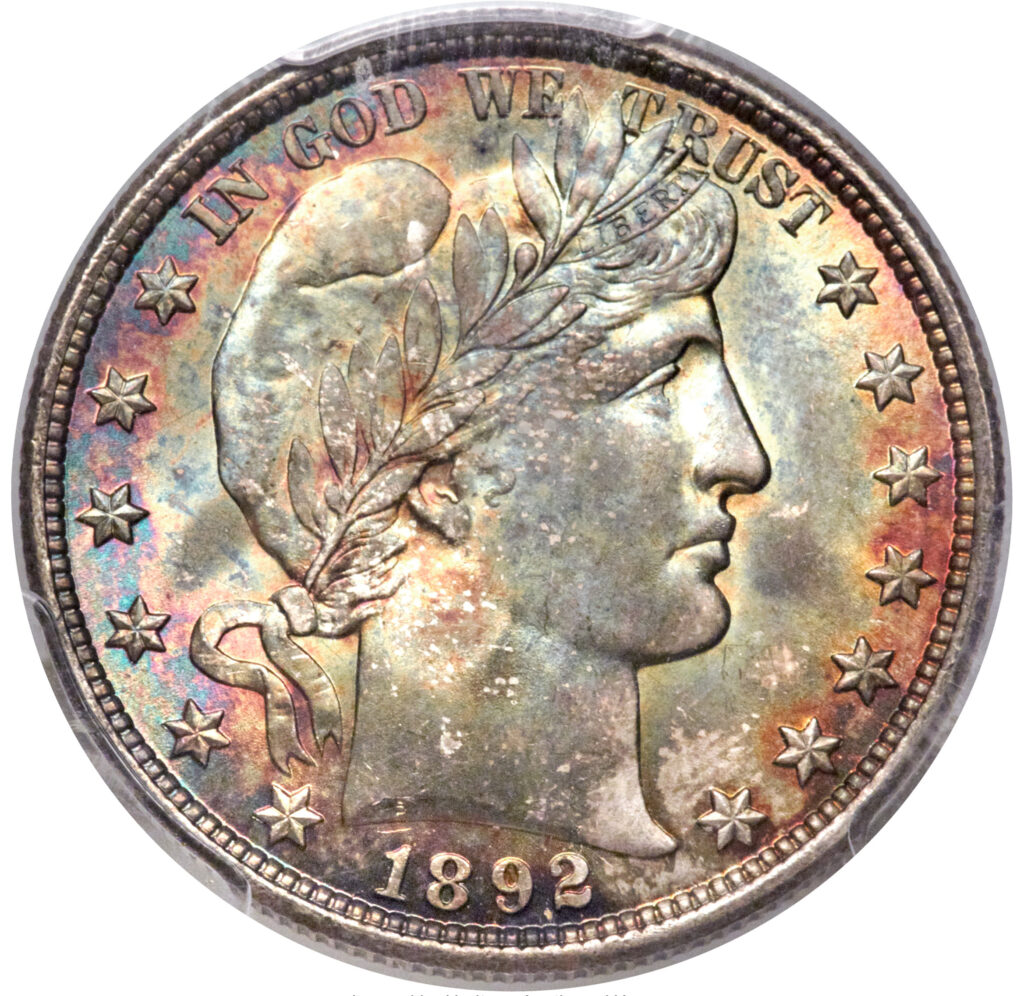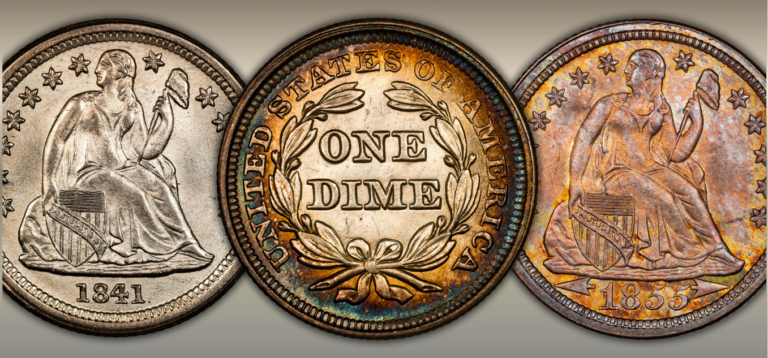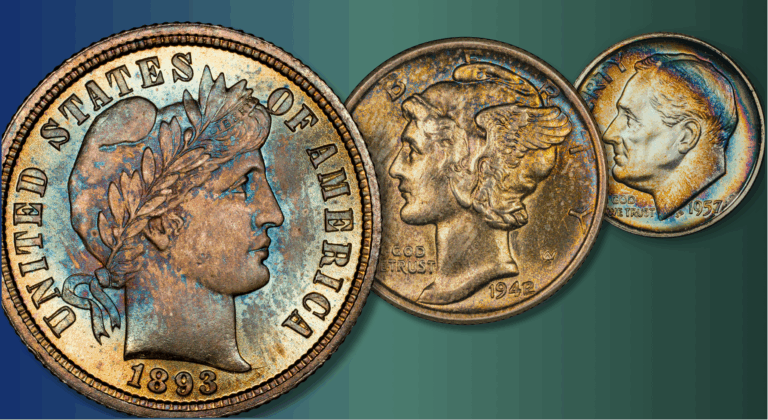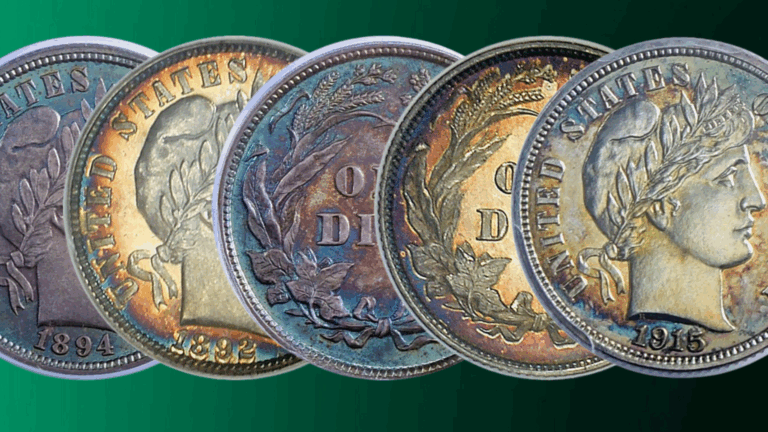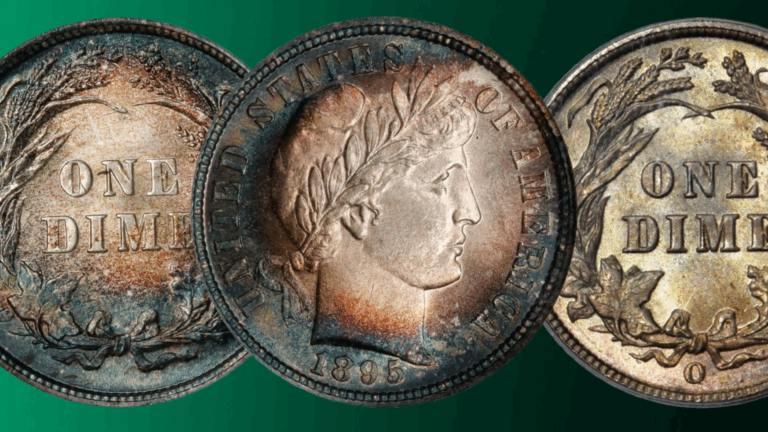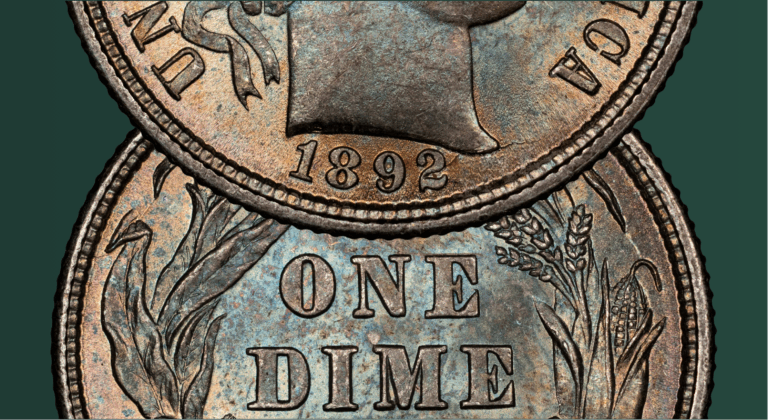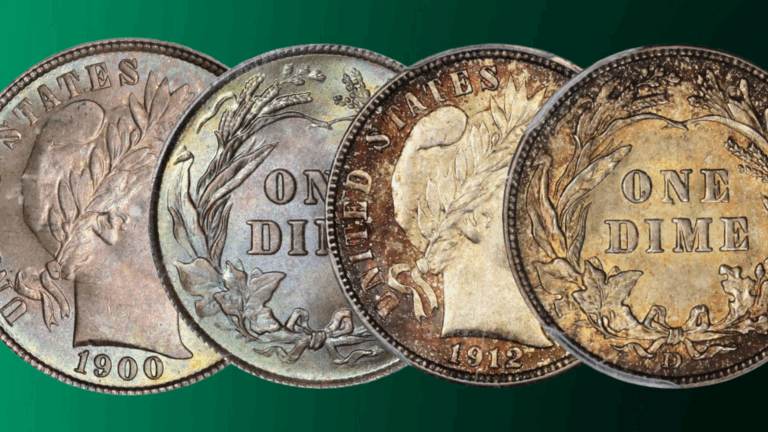By Greg Reynolds
Some background information about Barber half dollars is put forth in an accompanying article on building a set in XF to AU grades. This discussion is about assembling a set of Barber halves ‘by date’ in MS-64 to MS-65 grades. It is practical to complete such a set, and MS-64 to MS-65 grade Barber halves cost dramatically less than Barber halves that have been certified as grading MS-66 to MS-68. Moreover, coins in the MS-64 to -65 grade range tend to be attractive to very attractive, with just mild contact marks or hairlines. Most U.S. coin collectors like them.
A relevant question is why not put together a set of Barber halves that grade above AU-55 and below MS-64? Are those that grade from AU-58 to MS-63 good values?
Barber Half Dollars AU 55 to MS64 Vary Greatly
To most interested collectors, I would not recommend collecting Barber halves that are certified as grading AU-58. While Barber halves that are certified by PCGS or NGC as grading AU-58 usually have just slight wear, they vary tremendously in terms of surface quality, originality and eye appeal. Two certified “AU-58” Barber halves that have about the same level of wear or light friction are often very different in other ways.
The issues surrounding really appealing, relatively original Barber halves that are certified as grading AU-58 are especially complicated. They often sell for MS-61 to MS-63 level prices. In contrast, Barber halves with annoying imperfections or are far off-color may fairly grade AU-58, too, yet may be unappealing, especially if they have been chemically cleaned in the past or are full of hairlines from an extensive moderate cleaning.
Naturally toned, very much original Barber halves in the XF-40 to AU-55 range or the MS-64 to -65 range are, on average, more logical selections than corresponding Barber halves that are certified as grading from AU-58 to MS-63. A majority of Barber coins that are certified as grading from MS-60 to MS-63 have very noticeable negative characteristics like many hairlines, numerous contact marks, somewhat unattractive toning, general dullness and/or very apparent after-effects of a mild to medium-level chemical cleaning.
Of course, not every certified MS-60 to MS-63 grade Barber half dollar has readily apparent negative issues. Occasionally, I will see one that I find to be appealing. Generally, though, I recommend against them. Collectors who desire though cannot afford MS-64 to MS-65 grade Barber coins should probably seek instead Very Fine to AU grade coins with natural toning and pleasant surfaces overall.
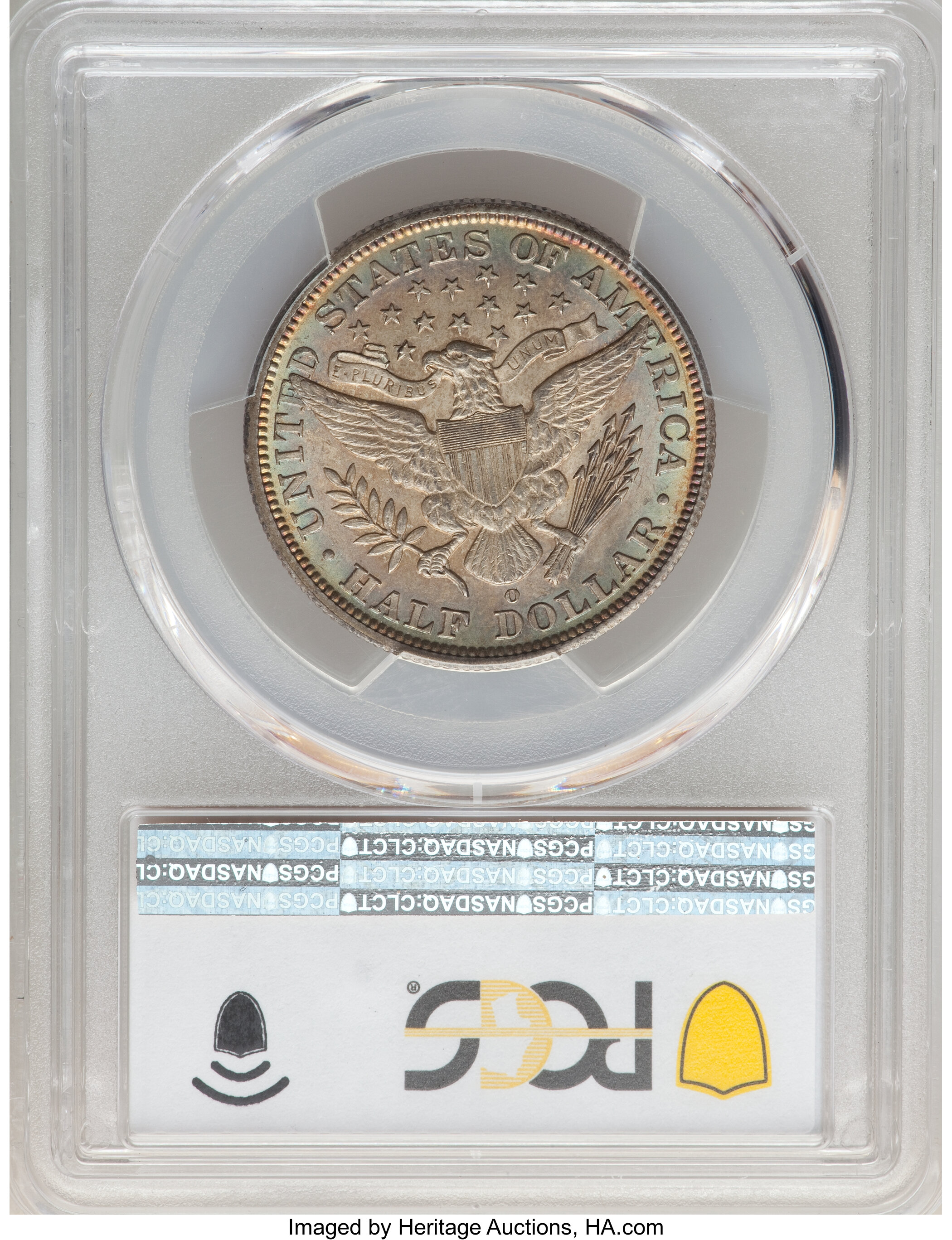
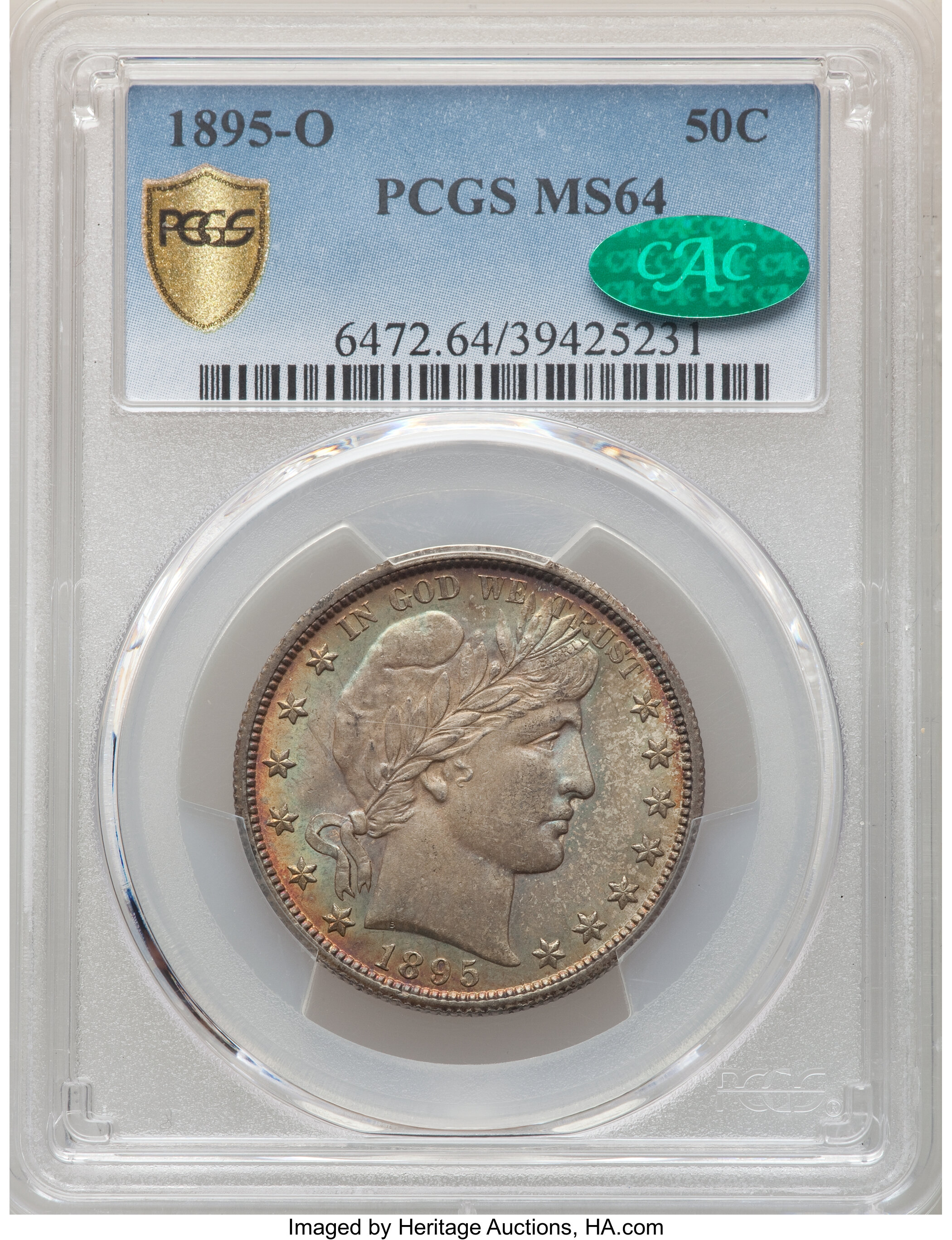
Collecting Mint State Barber Halves
A collector who desires and can truly afford MS-64 to MS-65 grade Barber halves should think about the characteristics of coins that are important to him or her. There are Barber coin collectors who are very much bothered by small contact marks and short hairlines on Miss Liberty’s face, while other collectors focus more on the color or luster of each coin overall. Some collectors like blue, russet and gray toning, which are colors that frequently appear naturally on silver coins. Many collectors like vibrant luster. Others prefer a more satiny texture.
I continue to be astonished by the collectors who like an artificial dipped-white color, especially in regard to Morgan dollars. I prefer medium gray, green and russet tones that developed gradually over a period of decades. It is true, however, that there are many dates in the series of Barber halves that are condition rarities in grades above MS-63. For those dates, time-conscious collectors may not have the luxury of focusing on aesthetics and must instead buy the fairly graded coins that are available in order to complete a set in a particular period of time. Some collectors have more patience than others.
An overall point is that a collector should develop a strategy or at least an approach to each collecting project. A coin that thrills one serious collector may seem unappealing to another collector. In regard to Barber halves, it is easy for collectors to find exceptionally appealing representatives of the least scarce dates, which are usually called ‘common dates.’
Rather than analyzing individual coins, the emphasis here is upon information and ideas. One purpose is to introduce collectors to the idea of completing a set of Barber halves in the MS-64 to MS-65 range. A second purpose is to provide general information regarding the costs of assembling a set of Barber halves MS-64 to -65 grades. A third purpose is to shed light upon the challenges involved. It would not be fun to complete a set that is too easy. Collectors like projects that are both fun and realistic.
Mentions of individual coins in public sales are intended as general information. I am not here recommending specific coins. Furthermore, no one should draw firm conclusions about coins solely from examining images. When coins are carefully examined in actuality, there is much that is seen that is not apparent in pictures.
As market levels for the least scarce dates (“common dates”) may be discerned by referencing price guides, checking records of public sales, browsing dealer websites, and attending coin shows, I comment here on some of the scarcer dates, for which market levels and availability are not easy to figure out. For decades, I have devoted much time to high grade Barber coins.
Ignoring the 1892-‘Micro O,’ there are seventy-three dates (including U.S. Mint locations) in the series of Barber Half Dollars. The 1892-‘Micro O’ is an anomaly with a smaller mintmark. It is not needed for a complete set ‘by date.’
In the series of Barber halves, most of the ‘common dates’ are from the 20th century. They are not common, however, in the sense that ‘late date’ Walkers and Franklin half dollars are common. Each date in the series of Barber halves is notably scarce in grades above MS-62.
Those beginning a set of Barber halves may be glad to learn that it is not difficult to find a high grade 1892. It is or was typical for many representatives of the first year of a new design type to be saved by the general public. New coin issues received a great deal of publicity in their own time. Also, people who noticed them in change went to banks and asked for uncirculated representatives of new issues.

Public Sales and CAC Premiums for MS Barber Halves
In August 2021, Heritage auctioned a PCGS graded MS-65+ 1892, with a sticker of approval from CAC, for $2640, a fair collector price. Experts at CAC ignore the plus aspect of plus grades assigned by PCGS or NGC. In regard to any coin that is CAC approved, experts at CAC usually do not reveal whether they find the grade to be in the high end of the given whole number range. For example, if a Barber half that is graded MS-64 or -64+ is approved, experts at CAC will not reveal whether they find the grade of the respective coin to be in the ‘high end’ or the ‘middle’ of the MS-64 range.
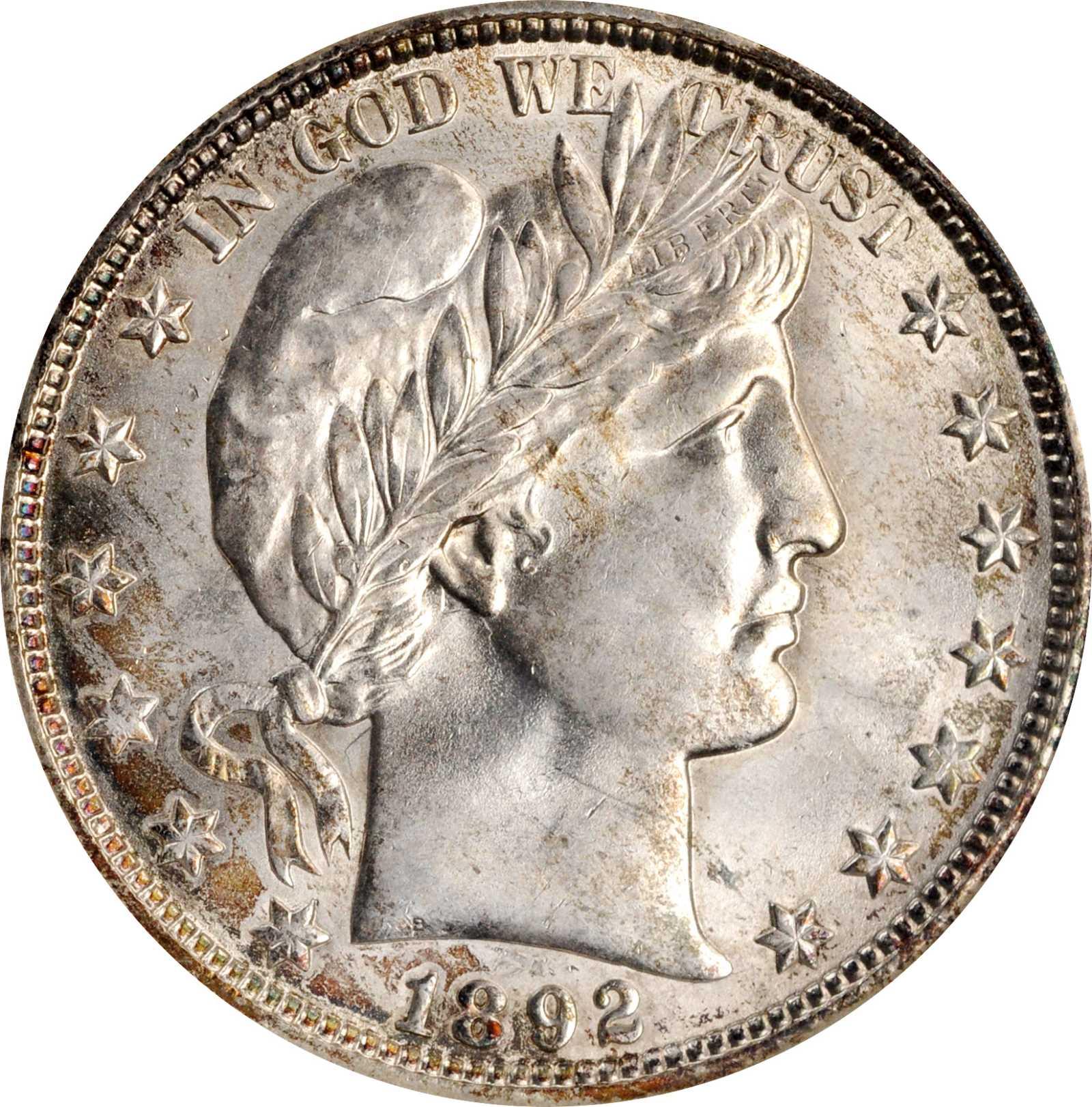
The 1892-O is scarcer than the 1892 Philadelphia Mint issue, though is not extremely scarce. On Dec. 17, 2020, Stack’s Bowers auctioned a CAC approved, NGC graded MS-64 1892-O from the Larry Miller Collection. It realized $2400. This would be a very fair price now in the summer of 2022, though it might take time to find a CAC approved 1892-O. CAC has approved eight as MS-64 and just three at the MS-65 level, plus four at higher levels.
The 1892-S is a condition rarity in uncirculated grades. PCGS and NGC reports include some multiple counts of individual coins.
On Dec. 17, 2020, Stack’s Bowers auctioned the Larry Miller Collection, CAC approved, PCGS graded MS-65 1892-S realized $6600. As of July 5, 2022, the CPG-CAC medium retail estimate is or was $7200. As with many ‘early date’ Barber halves, really appealing representatives do not appear often, and interested collectors should be ready to pay full retail prices for them.
The 1893 is one of the least scarce early dates. A CAC approved MS-64 grade 1893 should retail for less than $1500. A CAC approved MS-65 grade 1893 could very well sell for a price anywhere from $2000 to $3000.
As for the 1893-O, CAC has approved seven as MS-64 and just one as MS-65. In August 2021, Heritage auctioned a PCGS graded MS-64+ 1893-O for $2400 and a PCGS graded MS-65+ 1893-O for $8100. Both of them had CAC stickers. Legend had auctioned the just mentioned PCGS graded MS-65+ 1893-O, with the same PCGS serial number, almost six months earlier, for more, $8812.50. This is the only 1893-O that CAC lists as being approved in the MS-65 grade range. Although the CPG-CAC medium retail estimate for it is $10,000, I find that number to be too high. A fair collector price might be between $8550 and $9250.
Rather than spend that much for an MS-65 1893-O, budget-minded collectors may prefer one of the seven that have been CAC approved at the MS-64 level. The CPG-CAC medium retail price estimate of $1750 is probably too low for one of those. A medium fair collector price for a CAC approved MS-64 1893-O is around $2000 in July 2022, in my view.
1893-O and 1893-S Barber Half Dollars
In grades above MS-63, the 1893-S is considerably rarer than the 1893-O. In their book on Certified Barber Coinage (DLRC: Virginia Beach, 1999), David and John Feigenbaum remarked that “Neither the 1893-O or 1893-S is as available as one would think. Don’t pass up any decent specimens of the 1893-O, and any specimens at all of the 1893-S” (page 85).
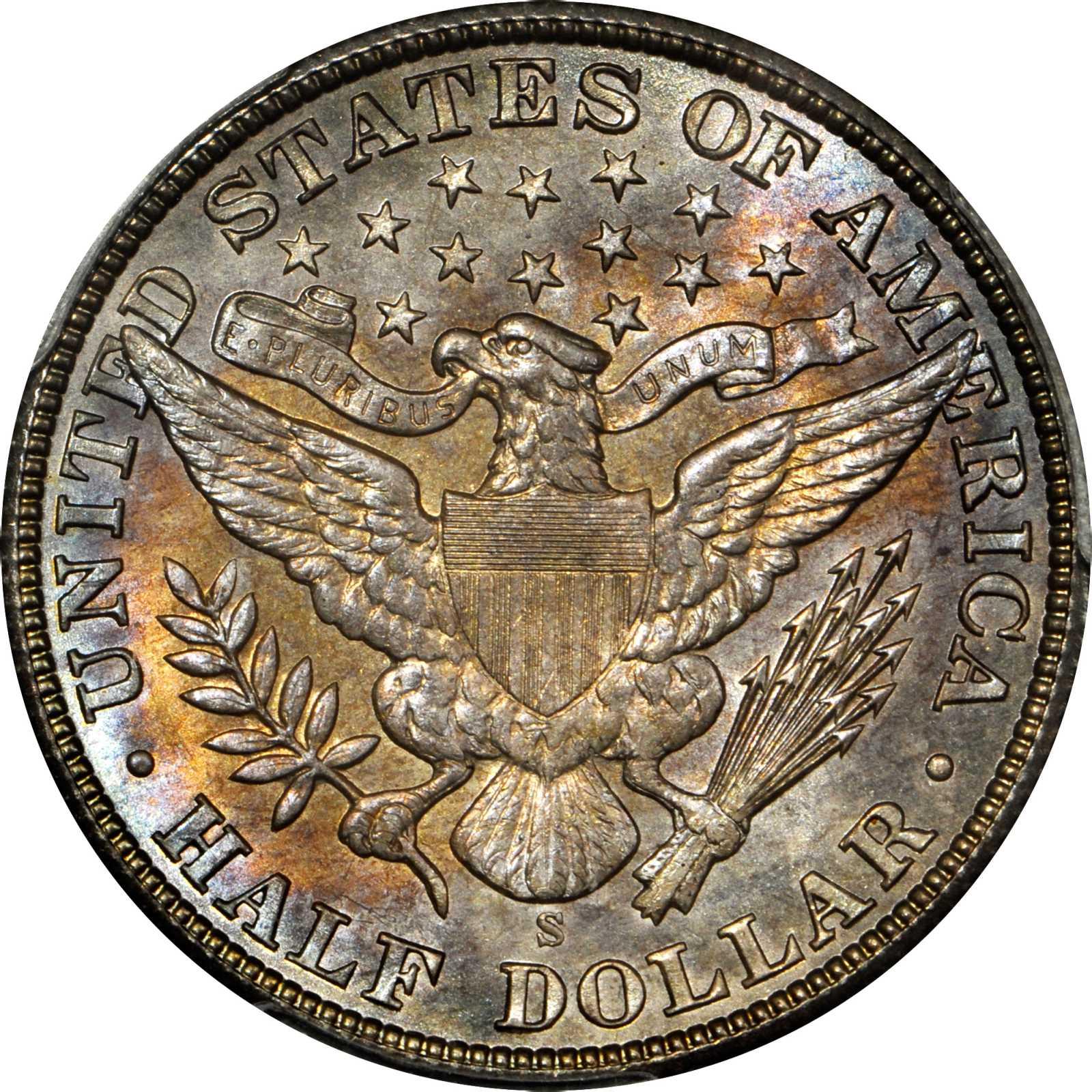
On April 23, 2020, Heritage auctioned a CAC approved MS-65 grade 1893-S for $9900. Then and in July 2022, a $9900 result was a weak price. A top-wholesale price would be more than $10,500. A fair retail price during July or August 2022 for a CAC approved MS-65 1893-S would be in the range of $12,000 to $15,000.
Although I did not see this CAC approved MS-65 1893-S that sold in April 2020, I did examine the Shireman Collection 1893-S, which was also PCGS graded MS-65 and CAC approved. There is a good chance that the 1893-S that was auctioned for $9900 in 2020 is superior to the Shireman coin, which realized $16,450 in January 2016. From 2014 or 2015 to 2019, market levels for many high grade Barber coins decreased.
A CAC approved MS-64 grade 1893-S tends to cost less than half as much as a corresponding MS-65 grade 1893-S. On March 26, 2020, Legend auctioned a PCGS graded MS-64+ 1893-S, with a CAC sticker, for $4935.
1894 and 1895 Barber Half Dollar Premiums
Although I have personally seen very few, really appealing MS-64 to -65 grade 1894 and 1895 Philadelphia Mint halves during the last three decades, these are regarded as just slightly scarcer than common dates in MS-64 grade and do not command much of a premium.
On Jan. 4, 2017, Heritage auctioned a PCGS graded MS-65+ (sixty-five-plus) 1894, with a CAC sticker, for $1997.50. Then in 2017 and now in July 2022, that was a wholesale price. A medium retail price for that 1894 half would be substantially higher, closer to $3000. If a CAC approved MS-64 (sixty-four) grade 1894 became available during the summer or autumn of 2022, a fair collector price would be around $1500.
The 1894-O is a much better date overall and an extreme condition rarity in grades above MS-63. I suggest consulting an expert before buying one.
Although price guides provide an impression that MS-64 to -65 grade 1894-O halves are less expensive and not as scarce as similar 1894-S halves, my observations, decades of experience and research suggest that the 1894-O is rarer than the 1894-S in this grade range. Nevertheless, the 1894-S is elusive, too.
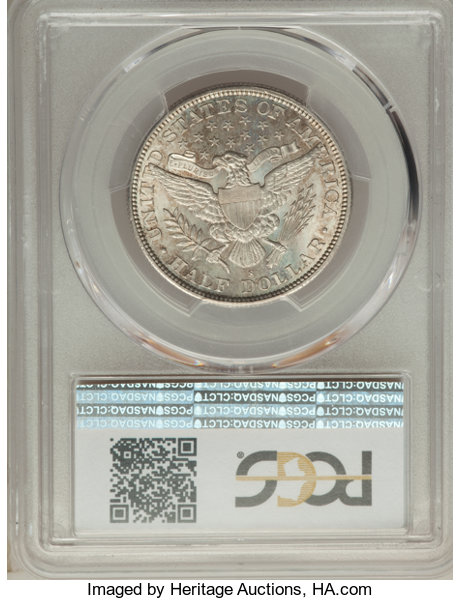
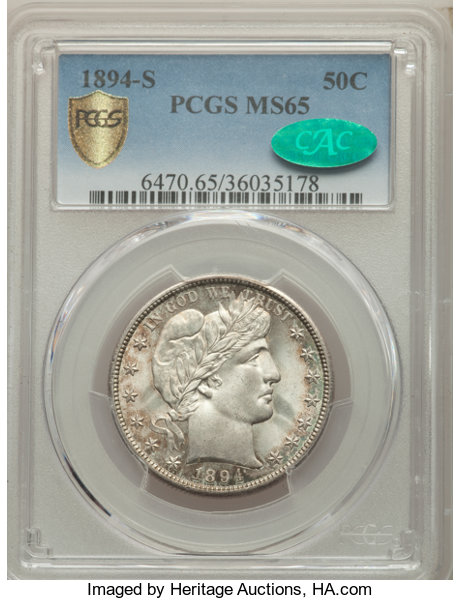
For both the 1894-O and 1894-S, I am certain that PCGS and NGC data includes significant multiple counts of some of the same coins. The population totals for MS-64 1894-O and 1894-S halves seem especially bloated. For decades, there have been active wholesalers who make a substantial portion of their respective incomes by removing classic U.S. coins from PCGS or NGC holders and resubmitting them over and over again. A few such wholesalers, ‘crackout artists,’ do not return the removed printed labels (‘inserts’) to PCGS and NGC.
On April 5, 2022, Stack’s Bowers auctioned a CAC approved, MS-64 grade 1894-S for $1800. On Dec. 6, 2019, Heritage sold a CAC approved MS-65 grade 1894-S for $5400.
The 1895 Philadelphia Mint issue is not regarded as being particularly scarce. On Nov. 15, 2018, Legend auctioned a PCGS graded MS-65+ 1895, with a CAC sticker, for $2585.
Back on Jan. 8, 2017, Heritage auctioned a CAC approved, NGC graded MS-64 1895 for $998.75. It was earlier in the famous Richmond Collection, which DLRC auctioned in 2004 and 2005. The relative completeness of The Richmond Collection was extremely impressive. Among other rarities, it included the highest certified 1894-S dime, an 1854-S quarter eagle, a complete set of eagles (except the 1795 ‘Nine Leaves’), 1884 & 1885 Trade Dollars, and an 1870-S silver dollar.
This same Richmond Collection, NGC graded MS-64 1895 half dollar that sold for $998.75 in 2017 realized $1783 in March 2005. There are more than a few Barber coins that were worth more in 2005 than in 2022. The current Greysheet-CAC Bid for a MS-64 1895 half is $1200 and the CPG-CAC retail price estimate is $1500.
Many certified XF-40 to MS-67 grade 1895-O half dollars have moderate to serious problems or are overgraded in my personal opinion. It may require considerable patience to acquire an excellent 1895-O that is certified in the MS-64 to -65 range. The 1895-O, though, is not one of the more expensive dates in the series.
On Aug. 20, 2021, Heritage auctioned a CAC approved MS-64 grade 1895-O for $2400. There are a larger number of MS-63 to MS-67 grade 1895-S halves around than I would have guessed if I was asked decades ago. The CPG-CAC retail price estimate for a MS-64 1895-S is $2700 and is $5000 for a MS-65 grade 1895-S. My impression in July 2022 is that these two estimates are probably a little bit low.

Show off Your Collection in the CAC Registry!
Have CAC coins of your own? If so, check out the CAC Registry–the free online platform to track your coin inventory, showcase your coins by building public sets, and compete with like-minded collectors!
Public Sale of the 1896 to early 1900s Barber Halves
With patience, neat MS-64 grade 1896 and 1896-S halves could be acquired for prices that are reasonable in the context of assembling a set of MS-64 to -65 grade Barber halves. The 1896-O is much scarcer than the 1896 or the 1896-S. Indeed, the 1896-O is one of the scarcest dates in the series, perhaps the leading semi-key. During the summer or autumn of 2022, an MS-64 grade 1896-O would probably cost between $15,000 and $22,500. An MS-65 grade 1896-O might not cost much more.
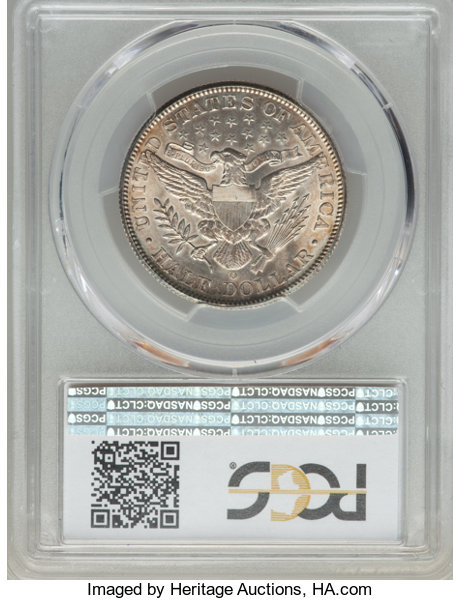
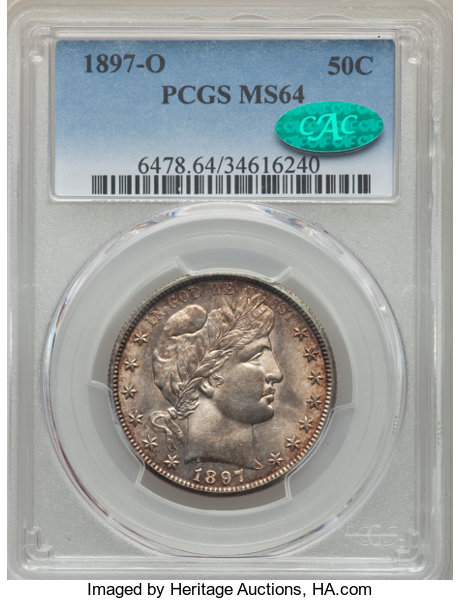
The 1897 is only a slightly better date. The 1897-O is definitely a better date and is a CAC rarity in uncirculated grades. On Feb. 22, 2018, Heritage sold a CAC approved MS-64 grade 1897-O for $5280. This same coin would wholesale for more than $5500 if available during the summer or autumn of 2022. Would a fair collector price for that 1897-O be around $7000?
Among Barber halves minted from 1899 to 1905, there are many dates that are CAC rarities although there are sizable populations in the MS-64 to MS-65 grade range listed for each by PCGS and NGC. In cases where it is not feasible to acquire a CAC approved coin of one of the better dates in the series, it is a good idea for a collector to hire an expert to assist him or her. An appropriate expert should explain the positive and negative aspects of individual coins so that collectors are suitably informed before making their own decisions.
It might not be practical to acquire a CAC approved 1900-O that grades MS-64 or MS-65 in the near future. Again, it is a good idea to discuss non-CAC 1900-O halves with someone who has decades of experience examining uncirculated Barber coins. Ever since I started attending major coin auctions, I focused upon them. I have written many articles about Barbers, some devoted to gem quality coins, others that focused upon circulated coins.
The 1904-S is the key, if the 1892-‘Micro O’ is ignored. In VF-20 to MS-62 grades, especially above XF-40, the 1904-S is clearly the most valuable date in the series of Barber half dollars.
In Good-04 grade, there are a few dates that are worth more than a 1904-S, including the 1893-S, 1897-O, 1914 and 1915. In Fine-12 grade, the 1904-S is probably worth the most, though the 1893-S and 1897-O are nearly as valuable. The 1897-S and 1914 are surprisingly expensive in F-12 grade, though not nearly as costly as a F-12 grade 1904-S. In VF-20 grade, the 1893-S and the 1897-O are in a mildly lower price range. In XF-40 grade the 1896-O and the 1904-S are the only two Barber halves that are worth over $2000. In MS-64 grade, the 1904-S is worth maybe 20% to 27.5% more than an equivalent 1896-O.
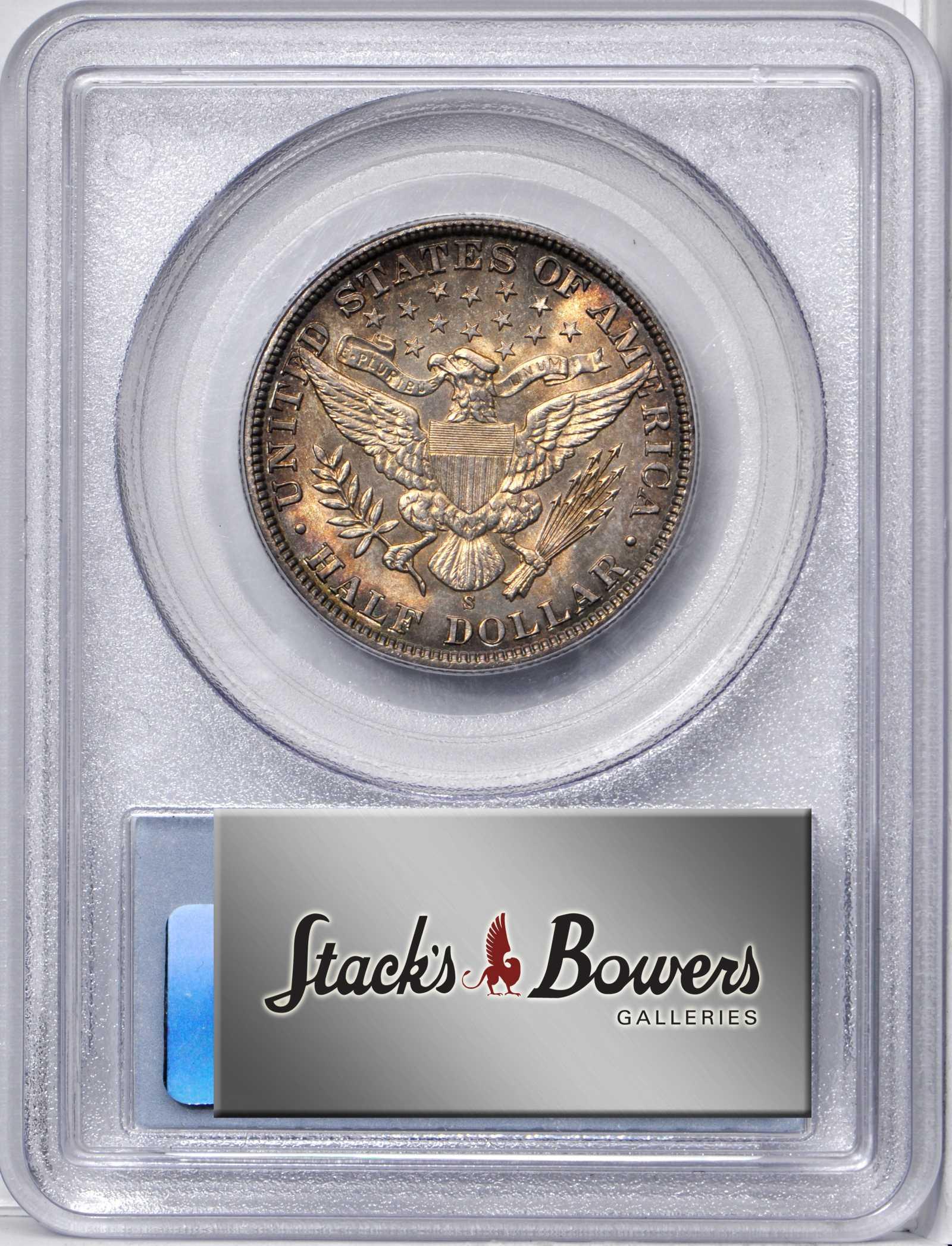
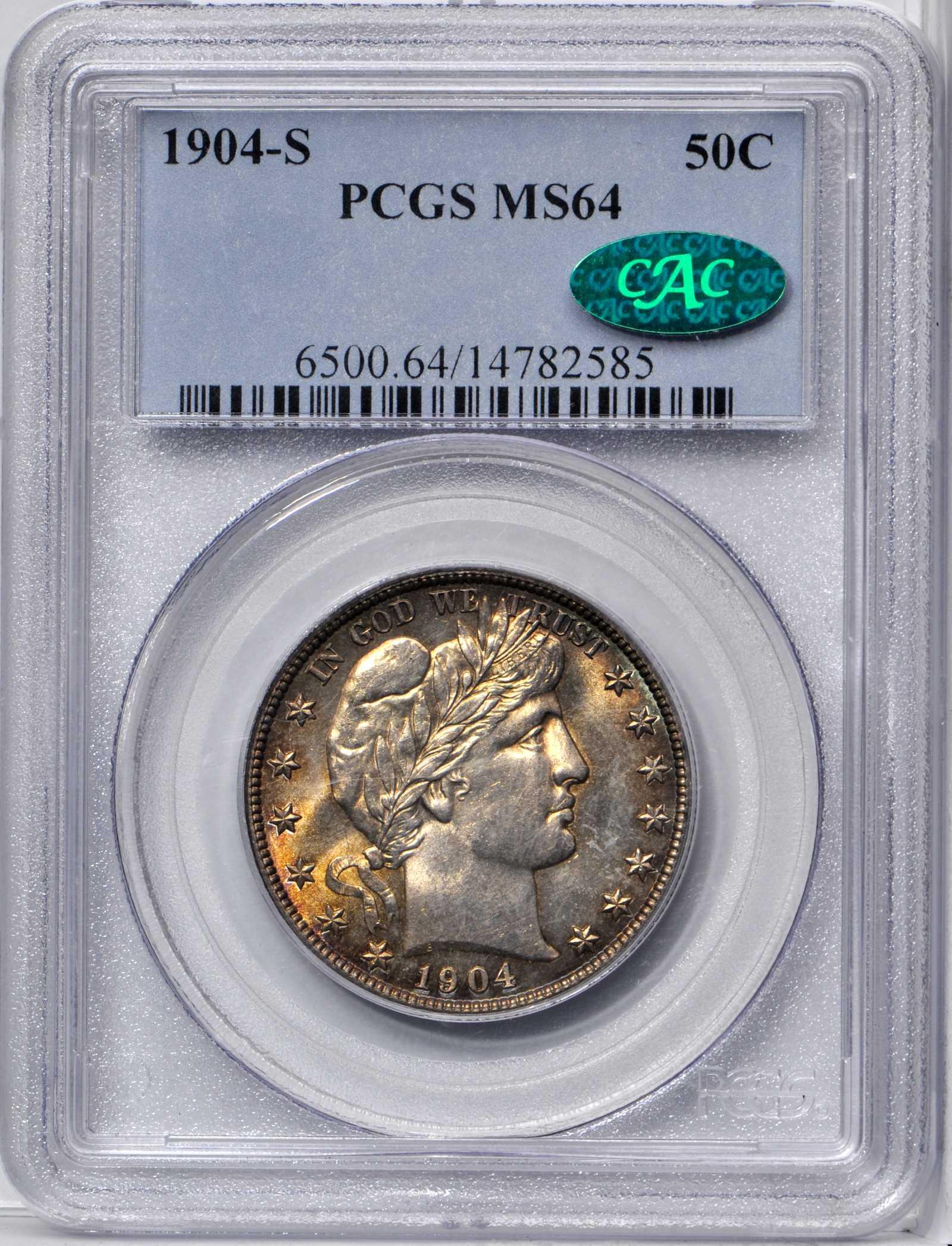
The 1904-S from the “A. J. Vanderbilt Collection” was auctioned twice by Stack’s Bowers. On March 22, 2018, while PCGS graded MS-64, with a CAC sticker, it realized $20,400. Later, it was upgraded by PCGS to “64+.” On June 18, 2020, it brought less, after being upgraded, $18,000, though it was no longer fresh. The “A. J. Vanderbilt Collection” was an impressive and important consignment in 2018.
A different PCGS graded MS-64+ 1904-S, with a CAC sticker was auctioned by Stack’s Bowers on June 22, 2018 for $19,800. Only one 1904-S is listed in the CAC population report as grading in the MS-65 range, though PCGS reports six and NGC, one. The combined PCGS and NGC total for 1904-S halves in the MS-64 range is twenty-one, perhaps a dozen of which are different coins.
Given the costs of these, the rarity of CAC approved MS-64 to -65 1904-S halves, and the fact that I am not thrilled about most of the certified “MS-64” or “MS-64+” 1904-S halves that I have seen, I strongly suggest consulting an expert before buying one. For those budget-minded collectors who can afford a 1904-S, it is sensible to seek a decent, tolerably graded 1904-S for a fair collector price. Unfortunately, I have seen several that are indecent.
Collecting Sets by Date for Barber Half Dollars
For dates in the series of Barber halves, it is not unusual for a MS-65 grade coin to be worth 50% to 100% above the value of a certified MS-64 grade coin of the same date, or even more than 100%. For example, the CPG-CAC retail price estimate for a MS-64 1898-O is $3750, yet the CPG-CAC retail estimate for MS-65 1898-O is $8250. For “common dates,” which I call the least scarce dates, such as the 1911, 1912 and 1915-D, the CPG-CAC retail estimates are $1350 in MS-64 and $2250 in MS-65, 67% more.
While there never will be unanimous agreement among experts regarding a list of “common date” Barber halves, those with the lowest CPG retail price estimates are likely to be common dates or almost so. While all Barber halves are scarce in grades above MS-63, it is apparent that some are much scarcer than others.
As for whether a MS-65 grade coin should be worth 50% to 150% more than a MS-64 grade coin of the same date, each collector should form his or her own opinions and thus not take orders from dealers. It is important to think about the positive and negative aspects of individual coins and the differences between MS-64 and MS-65 grade Barber halves.
It might be a good idea to start by acquiring more than a half-dozen common date Barber halves with CAC stickers, including at least three that are CAC approved in the MS-64 grade range and at least three that are CAC approved as MS-65. Collectors may learn by studying them. Indeed, a collector who is unsure about his or her strategy or budget may wish to acquire common date and slightly better date Barber halves while beginning a set and later pursue much better dates.
Images are copyrighted by Stack’s Bowers Galleries (www.stacksbowers.com) and Heritage Auctions (www.ha.com).
Copyright © 2022 Greg Reynolds
About the Author
Greg is a professional numismatist and researcher, having written more than 775 articles published in ten different publications relating to coins, patterns, and medals. He has won awards for analyses, interpretation of rarity, historical research, and critiques. In 2002 and again in 2023, Reynolds was the sole winner of the Numismatic Literary Guild (NLG) award for “Best All-Around Portfolio”.
Greg has carefully examined thousands of truly rare and conditionally rare classic U.S. coins, including a majority of the most famous rarities. He is also an expert in British coins. He is available for private consultations.
Email: Insightful10@gmail.com
